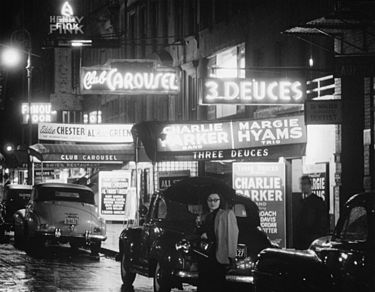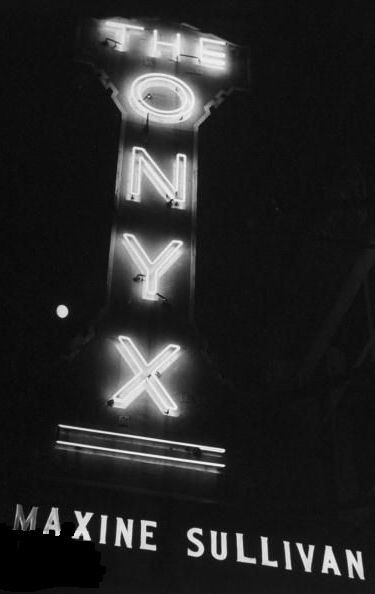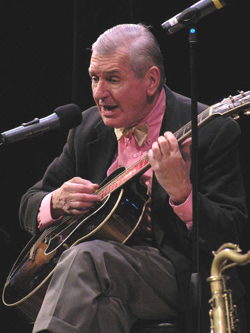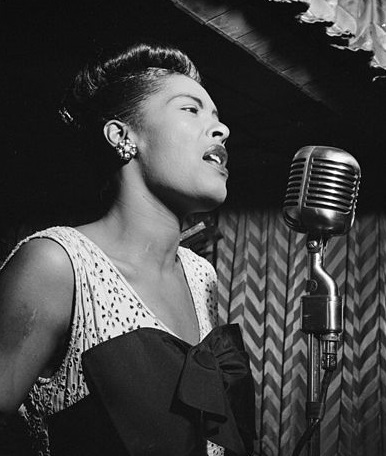
52nd Street, New York City in the 1940s. Photo by Wm. Gottlieb in public domain, library of congress.
There’s Bourbon Street in New Orleans and Rush Street in Chicago, but there was nothing quite like 52nd Street in New York City in the 1930s and 40s. This week, we conjure up the glamor and glorious music of Swing Street, the Street of Jazz, as The Jim Cullum Jazz Band welcomes our good friends, the master guitarist and raconteur Marty Grosz, and a star of Broadway and the movies—Carol Woods.
The action on 52nd Street started during Prohibition. Joe Helbock, bootlegger, bartender and self-appointed patron of jazz, counted Teddy Roosevelt as one of his best customers for home delivery of booze. “We were polite bootleggers,” Joe said, “We made our deliveries in brief cases instead of paper bags.” Helbock opened the Onyx Club in 1927 in a one-room, walk-up apartment in a brownstone on 52nd Street. The walls were decorated with black and silver stripes, with a black marble bar at the back. Joe knew every musician in town. The Onyx Club became the hangout for his friends. Jimmy and Tommy Dorsey. Art Tatum, Maxine Sullivan and Louis Prima all started their careers at The Onyx. Jim Cullum says, “This was a place where musicians could pick up phone messages or have their mail delivered, or even leave their horns for safekeeping.”

The Onyx Club. Photo courtesy Life Magazine.
The Onyx Club was a breeding ground for new tunes. “Undecided” by trumpet player Charlie Shavers is an enduring jam session favorite first introduced by John Kirby’s Onyx Club Sextet. Jim Cullum says, “One night Benny Goodman was sitting in the club when Kirby’s group played a tune that caught Benny’s attention. He sent a note up to the bandstand asking what the name of the tune was. Charlie Shavers hadn’t named it yet so he scribbled ‘Undecided’ on the back of the note and passed it back to Benny, and it’s been ‘Undecided’ ever since.
If you wanted to get into the Onyx Club, you found your way to No. 35 on 52nd Street between 5th and 6th Avenues. When you got there, you’d find a couple of stone steps leading down to a basement door that was always open. Heading down a long, dark hallway, you’d come to a back staircase and climb one flight. It was so dark you couldn’t see a foot in front of you. You’d knock on a door covered with silver paint. A guy would look at you through a peek hole. And if you said, “I’m from 802” (the number of the New York City Musicians’ Union local chapter) they’d let you in. As the door swung open, you’d hear the crazy madhouse of a jazz band stomping, tables overflowing. Everybody’s eating and drinking booze out of coffee cups. Joe Helbock presided over it all.

Marty Grosz.Photo courtesy of the artist.
Marty Grosz grew up in New York in the 1930s and 40s and remembers the heyday of 52nd Street. Marty performs two enduring hits to come out of the era with The Jim Cullum Jazz Band. “The Music Goes ‘Round and ‘Round” and “Flat Foot Floogie.”
Slim Gaillard and bassist and vocalist Slam Stewart were a popular 52nd Street duo, known as “Slim and Slam.” In 1938 they came up with what turned out to be a pop hit, “Flat Foot Floogie with the Floy Floy.”
The original title was “Flat Foot Floozie” but Gaillard changed it to “Flat Foot Floogie” to get it past the censors and have a shot at radio airplay. It worked— even though “floy floy” was a then-current slang for venereal disease. The lyric just sounded like a nonsense rhyme to the censors and many artists covered it. Benny Goodman had a number one hit with his recording, and when three records were selected to be memorialized in the Westinghouse time capsule—Benny Goodman’s recording of “Flat Foot Floogie” was in the time lock, along with Finlandia by Jean Sibelius and "The Stars and Stripes Forever" by John Philip Sousa.

Billie Holiday. Photo by Wm. Gottlieb in public domain, library of congress.
No doubt the greatest singer to come out of 52nd Street was Billie Holiday. Her songs of love and loneliness have had a lasting power and presence. Joining us this week, Carol Woods sings three classics made famous by Billie Holiday: “Lover Man,” “Them There Eyes” and “What a Little Moonlight Can Do.” Carol portrays Billie in excerpts from Holiday’s autobiography published in 1956, Lady Sings the Blues. “Lady Day” describes her difficult early life of poverty and privation, leading to musical inspiration from hearing recordings of Bessie Smith and Louis Armstrong while working as a cleaning woman in a brothel. Holiday wrote, “I guess I’m not the only one who heard their first good jazz in a whorehouse. But even if I heard Louis and Bessie at the Girl Scout Jamboree I’d have loved them just as much.”
In a piece narrated by Carol Woods, Billie Holiday is witness to the slow racial integration of 52nd Street.
You can be covered in white satin with gardenias in your hair, no sugar cane for miles, but you can still be working on a plantation. Well, take 52nd Street in the late ‘30s and early ‘40s. “Swing Street” they called it. Joint after joint was jumpin.’ White musicians were swinging from one end of 52nd Street to the other, but there wasn’t a black face in sight on the Street, except Teddy Wilson and me…But 52nd Street couldn’t hold the line against Negroes forever. Club owners found they couldn’t afford some of that old prejudice because they could make money off Negro artists. So, the barriers went down, and they gave jobs to a lot of great musicians.
.jpg)
Carol Woods.Photo courtesy of the artist.
From Prohibition to the Eisenhower era, 52nd Street was a place where musical styles mixed and mingled. Dixieland and Swing, Be-bop and Blues lined both sides of the Street. Politicians and song pluggers, businessmen, prostitutes and highbrows stood side by side, listening to the music. The Street was a never-ending block party. You could drop in on Billie singing the blues at The Onyx, or pick up on New Orleans-style bands at Ryan’s. And, if you were really somebody you might be able to drop by and get a table at 21. By the end of the evening you’d no doubt stop by and hear Lester “Prez” Young playing “Sometimes I’m Happy” at the Famous Door.
Jim Cullum says, “These guys were down there blowing every night of the week for over thirty years. At its peak 52nd Street had about 40 joints, and it was where it all happened.” Cullum describes his visit to Jimmy Ryan’s at the age of seventeen to see the de Paris Brothers Band, in honor of which the Cullum Band closes the show with a Wilbur de Paris original, “Wrought Iron Rag.”
Photo credit for Home Page. 52nd Street, NYC. Photo by Wm. Gottlieb in public domain, library of congress.
Text based on Riverwalk Jazz script by Margaret Moos Pick © 1990

